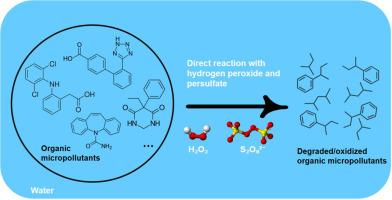过硫酸盐和过氧化氢直接氧化有机微污染物:在高级氧化过程中的潜在误导贡献
IF 7.1
Q1 ENGINEERING, CHEMICAL
引用次数: 0
摘要
高级氧化工艺(AOPs)在去除水中有机微污染物(OMPs)方面越来越有吸引力。然而,aop的各个方面需要仔细评估。大多数AOPs涉及引入氧化剂,如过氧化氢和过硫酸盐,它们随后被紫外线照射、臭氧、溶解的过渡金属、固体催化剂或其他技术激活。然而,OMPs与过氧化氢/过硫酸氢的直接反应很少被讨论。在这项研究中,在没有任何活化的情况下,在黑暗条件下,研究了八种omp(包括安赛蜜、阿替洛尔、卡马西平、双氯芬酸、美托洛尔、primidone、糖精和缬沙坦酸)与过氧化氢/过硫酸盐之间的直接反应。为了评估水基质的影响,比较了去离子水、自来水和废水中omp的去除率。结果表明,直接反应对大多数OMPs的氧化有不同程度的影响。值得注意的是,双氯芬酸是一种被广泛研究的指示污染物,在最高氧化剂剂量(2 mM)和接触时间(240 min)下,双氯芬酸可以通过与过氧化氢和过硫酸盐的直接反应完全去除。卡马西平是另一种经过充分研究的指示污染物,过氧化氢和过硫酸盐的去除率分别约为30%和55%。阿替洛尔和美托洛尔也表现出高氧化性,特别是与过硫酸盐一起,去除率超过70%。此外,还研究了选定转化产物的形成,以更深入地了解反应机理。本文章由计算机程序翻译,如有差异,请以英文原文为准。

Direct oxidation of organic micropollutants by persulfate and hydrogen peroxide: A potentially misleading contribution in advanced oxidation processes
Advanced oxidation processes (AOPs) are becoming increasingly attractive for the removal of organic micropollutants (OMPs) from water. However, various aspects of AOPs need to be carefully evaluated. Most AOPs involve the introduction of oxidants such as hydrogen peroxide and persulfate, which are subsequently activated by UV irradiation, ozone, dissolved transition metals, solid catalysts, or other techniques. However, the direct reactions between OMPs and hydrogen peroxide/persulfate are rarely discussed. In this study, direct reactions between eight OMPs including acesulfame, atenolol, carbamazepine, diclofenac, metoprolol, primidone, saccharin, and valsartan acid and hydrogen peroxide/persulfate were investigated without any activation and under dark conditions. To evaluate the impact of the water matrices, removals of OMPs were compared in deionized water, tap water and wastewater effluent. The results demonstrated the influence of direct reactions on the oxidation of most OMPs to varying extents. Notably, diclofenac, a widely studied indicator contaminant, could be completely removed through direct reactions with both hydrogen peroxide and persulfate under the highest oxidant dose (2 mM) and contact time (240 min). Carbamazepine, another well-studied indicator contaminant, showed removals of approximately 30% and 55% with hydrogen peroxide and persulfate, respectively. Atenolol and metoprolol also exhibited high oxidation, particularly with persulfate, achieving removals exceeding 70%. Furthermore, the formation of selected transformation products was also studied to gain deeper insights into the reaction mechanisms.
求助全文
通过发布文献求助,成功后即可免费获取论文全文。
去求助
来源期刊

Chemical Engineering Journal Advances
Engineering-Industrial and Manufacturing Engineering
CiteScore
8.30
自引率
0.00%
发文量
213
审稿时长
26 days
 求助内容:
求助内容: 应助结果提醒方式:
应助结果提醒方式:


